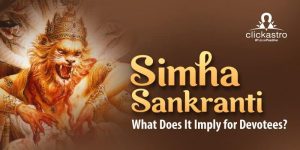In the
Hindu calendar, there are twelve Sankranthi which devotees celebrate. Sankranti is the day of the solar transition from one zodiac sign to another. Simha Sankranti marks the movement of the Sun, from Karaka Rashi or Cancer to Simha Rashi or Leo.
This year, Simha Sankranti will fall on Friday, August 16,
and it is believed that you should not take important decisions on this occasion.
Simha Sankranti or Simha Sankraman, as it is called in South India, falls during the Shravan Maas and the Dakshinayana phase or the southern journey of the Sun. Since it is a day related to the
planet Sun and Leo, this Sankranti is observed in the honour of the Sun, Lord Vishnu and Vishnu’s avatar Narasimha. The festival is celebrated largely in South India and marks the start of the Chinga month as per Malayalam calendar, Avni month in the Tamil calendar and Bhadra month according to the Bengali calendar.
Apart from South Indians, Simha Sankranti is mostly celebrated by people in the Kumaun region of Himachal Pradesh and Uttarakhand. One of the biggest customs on the day involves sankraman punya snan, wherein people bathe in holy water.
Simha Sankranti is considered an auspicious occasion for
performing poojas like Pitru Dosh Nivaran. This year, you should remember the following date and times for observing the festival optimally –
Read Graha Doshas and remedies: All you need to know
Important timings
Sunrise: August 16, 06:07 AM.
Sunset: August 16, 06:54 PM.
Punya Kaal Muhurta: August 16, 12:31 PM – 06:54 PM
Maha Punya Kaal Muhurta: August 16, 04:47 PM – 06:54 PM
Sankranti Moment: August 16, 07:45 PM.
Rituals you should follow
As you know, Simha Sankranti is a day devoted to Lord Vishnu, planet Sun and Lord Narasimha. Therefore, devotees should respectfully worship these three deities on this auspicious day. People also perform nariyal or coconut abhisheka on Simha Sankranti as a part of the holy bath. You should only use fresh coconut water for this ritual.
Remember to specially cleanse the coconut water used for nariyal abhishekha as it is an extremely important part of the ritual. Once this is completed, you should worship Lord Ganesha before moving to the other parts of the puja ceremony. This is done to appease Lord Ganesha and invite his blessings onto your rituals. It is also known as the appada puja. If you are a devout worshiper of Lord Vishnu, you can continue the Hoovina puja to Lord Vishnumurthy for the next one month, when the planet Sun will transit to Kanya rashi or Virgo.
During the puja on Simha Sankranti, you should offer flowers, fruits and different types of sweets to the deities, in addition to chanting mantras and seeking their blessings. This day is celebrated with great pomp and zeal at the main temple of Lord Vishnumurthy, which is situated in Kulai, near Mangalore. On this day, you will see the priest performing the rituals mentioned above, as per the muhurat timings. If you wish, you can also visit many temples in Kerala, Tamil Nadu, and Andhra Pradesh, where these prayers and rituals are observed faithfully on every Simha Sankranti.
Importance of Simha Sankranti
As this is an important day of worship for all devotees of Lord Vishnu, let us understand the religious connotations behind Simha Sankranti. The festival was conceived in the Kumaun belt of Himachal Pradesh and Uttarakhand, where, during the Chand dynasty reign, artisans visited the palace to display their beautiful creations.
Artisans used to visit the palace on the occasion of Simha Sankranti and they were handsomely rewarded for their efforts and art. The celebration then expanded to involve the common people of the dynasty, who started visiting the palace and offering fruits and flowers to the members of the royal family, which was known as the Rite of Olag. Further, people consumed bread made from horse beans on this day, after pouring lots of butter and ghee on it. The use of ghee on Simha Sankranti made people consider it as Ghrit Sankranti in the Bageshwar region of Kumaun, in Uttarakhand.
Therefore, it is believed that celebrating Simha Sankranti is good for traders and businessmen as it can help keep the cost of commodities normal while bringing them wealth and prosperity. It also brings good health for devotees, boosts affinity among nations and increases agricultural output.
Now that you know the importance of the festival, and the rituals to follow, we wish you a very auspicious Simha Sankranti.









